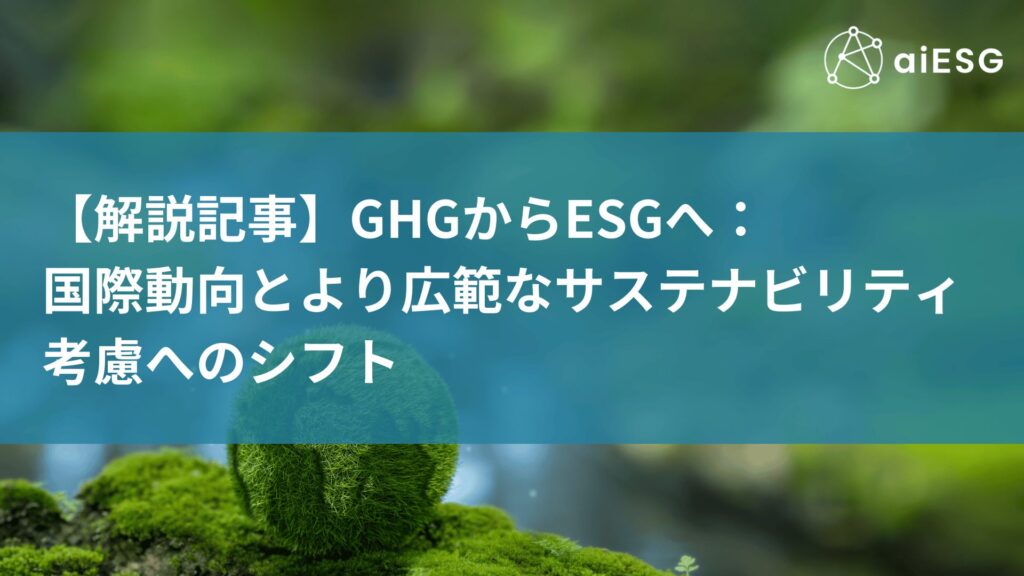INDEX
TNFD is something we hear more and more about these days.
Many of you may be wondering about the final recommendations as they are about to be released.
But what exactly is TNFD?
This article describes the background of its establishment, specific details, and the process of information disclosure.
What is TNFD?
The Taskforce on Nature-related Financial Disclosures (TNFD) is a framework for financial institutions and companies to properly assess and disclose the relationship between their business activities and nature. By understanding and disclosing the impact of their business on the natural environment and biodiversity, and conversely, the risks that companies are exposed to from changes in nature, companies are expected to identify their own risks and receive appropriate evaluations from investors and society.
The TNFD's final recommendations are scheduled to be released on September 18, 2023.The TNFD is a "Shift global financial flows from negative to positive outcomes for naturecompanies and financial institutions for the purpose of "toReport on nature-related risks and opportunities for your businessSince its establishment in June 2021, a beta version of the framework has been released four times.
The TNFD is positioned as a "natural version" of the TCFD (Task Force on Climate-related Financial Disclosures),[2] to which more than 90% of TSE prime listed companies are already compliant. After the release of the full version, it is expected that even more companies will move in earnest toward disclosure, but what process will actually be required?
Figure 1: TNFD Positioning (Source: TNFD Full Beta Summary v0.4)
Composition of TNFD
To begin, let us summarize the elements that make up the TNFD: As of Framework v0.4, released in March 2023, the TNFD consists of the following elements
Four pillars of recommendations
Four common pillars with the TCFD that can be tied to four recommendations that can be widely adopted
1. governance
2. strategy
Risk & Impact Management
Metrics & Targets
Recommended Disclosures
Fourteen specific recommendations, located under the four pillars (Figure 2)
General Requirements
Six general requirements across the four pillars of the disclosure proposal
Approach to materiality
Scope of disclosures
3. consideration of nature-related dependencies, impacts, risks and opportunities
4. location
Integration with other sustainability-related disclosures
6. stakeholder engagement
LEAP Approach
Voluntary guidance recommended to assist in TNFD disclosure. The four steps of Locate, Evaluate, Assess, and Prepare provide guidance in assessing nature-related risks and opportunities.
Figure 2: Draft TNFD Disclosure Recommendations (Source: TNFD Full Beta Summary v0.4)
Of these, the LEAP approach is not mandatory for disclosure, but is recommended for use as a means to prepare for the disclosure of information on nature-related issues. On the other hand,For disclosure recommendations based on the four pillars and the general requirements that cross these pillars, it is necessary to disclose information in compliance with these andYes.
Indicators used to measure and evaluate disclosure recommendations first published in Framework v0.4The first time the company was founded, it was in the process of being reorganized into a new company.Global Core Disclosure Indicators, which are strongly required to be disclosed in all sectorsThe following is a list of
| index number | category | summary |
| C1.0 | climate change | Scope 1, 2, and 3 GHG emissions |
| C2.0 | Changes in land/freshwater/sea use | Total change in land/freshwater/sea use |
| C2.1 | Changes in land/freshwater/sea use | Changes in terrestrial/freshwater/sea use in priority ecosystems |
| C3.0 | Contamination / Decontamination | Total amount of contaminants released into the soil by type |
| C3.1 | Contamination / Decontamination | Total volume of wastewater discharged and concentration of major pollutants in the wastewater |
| C3.2 | Contamination / Decontamination | Total amount of hazardous waste generated |
| C3.3 | Contamination / Decontamination | Total amount of air pollutants other than GHGs |
| C4.0 | Resource use/recharge | Water withdrawal and consumption from water stressed areas |
| C4.1 | Resource use/recharge | Amount of high-risk natural resources sourced from land/freshwater/sea |
| C4.2 | Resource use/recharge | Amount and percentage of natural resources sourced from priority ecosystems |
| C5.0 | Nature-related risks | Percentage and total annual revenue exposed to 1) physical risk and 2) transition risk |
| C5.1 | Nature-related risks | Percentage and total value of assets exposed to nature-related 1) physical risk and 2) transition risk |
| C5.2 | Nature-related risks | Percentage and value of assets/annual return at risk by risk rating (e.g., high, medium, low) |
| C5.3 | Nature-related risks | Percentage and total value of property values/annual revenues that are highly dependent on ecosystem services or have a significant impact on nature |
| C6.0 | Nature-related opportunities | Value of capital allocated to nature-related opportunities, by type |
Industry and Compliance Trends Prioritized for TNFD Disclosure
The TNFD has proposed priority sectors for each of the financial and non-financial sectors in the Framework v0.2 (Table 2). These sectors and industries "have greater natural dependencies and impacts than others and are more likely to be financially sensitive."[3] Priority sector-specific guidance/recommendations will be developed for these sectors. On the flip side, these are the industries most likely to be required to disclose information in compliance with the TNFD.
| sector | (the) industry |
| non-financial | |
| Food & Beverage | Meat, poultry and dairy products / Agricultural products / Alcoholic beverages / Non-alcoholic beverages / Processed foods |
| Renewable Resources and Alternative Energy | Forest Management / Pulp and Paper Products / Biofuels |
| infrastructure | Engineering and Construction Services / Water Supply and Distribution Services / Electricity and Power Generation |
| Mining, mineral processing | Construction Materials / Metals & Mining / Oil & Gas |
| health care | Biotechnology & Pharmaceuticals |
| resource transformation | chemistry |
| consumer goods | Apparel, Accessories, Footwear |
| transportation | Shipping Company / Shipping |
| financing | Banks/Insurance Companies/Asset Managers/Asset Owners/Development Finance Institutions |
Although the TNFD is prior to the release of the final recommendations, the number of organizations and companies that have already developed reports is growing. Below is a representative list of companies that have released TNFD reports by August 2023.
| Company Name | Open to the public | Report |
| Kirin Holdings Company, Limited | July 2022 July 2023 | Environmental Report 2022 and Environmental Report 2023 |
| Sumitomo Mitsui Financial Group | April 2023 | SMBC Group 2023 TNFD Report |
| Kao Corporation Accenture, Inc. | April 2023 | Business Risks and Opportunities Posed by Biodiversity - TNFD Assessment: A Case Study Based on Regional Characteristics |
| Shiseido Company, Limited | May 2023 | 2023 Shiseido Climate/Nature-related Financial Disclosure Report |
| KDDI Corporation | June 2023 | TNFD Report 2023." |
| NEC Corporation | July 2023 | NEC TNFD Report 2023 |
| tokyu land holdings inc. | August 2023 | TNFD Report - Contribution to Nature Positive in the Tokyu Land Holdings Group |
Process required for TNFD disclosure
The TNFD covers the huge concept of "nature" and is in the process of standardizing its definitions and indicators. Many companies may get stuck at the entrance when trying to formulate a report. Here, we will examine the necessary process based on the common features of TNFD reports that have already been published and the disclosure items that should be prioritized for investigation.
The four pillars of disclosure recommendations are key to compliance with the TNFD. These are "Governance," "Strategy," "Risk and Impact Management," and "Metrics and Targets. Of these, "Governance" and part of "Risk and Impact Management" can be satisfied to some extent by describing the company's actual structure and initiatives with respect to nature-related dependence and impact. On the other hand, "Strategy" and "Metrics and Targets" require disclosure of quantitative indicators and their measurement methods throughout the supply chain.It is not easy to obtain primary data for all required indicatorsThe TNFD report is a "sustainability report. In fact, many of the TNFD reports that have been released so far have been adapted from existing sustainability reports or focused on individual environmental initiatives, and it is likely that a format for disclosing information that covers all required indicators will not be established until after the full version is released.
The first step in pursuing disclosure is to understand the extent of dependence on and impact of nature for each of your business locations and industries, and to identify priority areas and activities to be considered. Proactive use of the LEAP approach can add persuasiveness to the analysis process.
Conclusion
The impact of the TNFD's penetration is not limited to large companies. Businesses upstream and downstream in the supply chain may increasingly be required by their suppliers to disclose information on nature-related risks. It will become more important than ever for each company to understand its dependence on and impact on nature in its business activities, even if this does not require a complete report.
aiESG provides support from the basics of TNFD to the actual disclosure of non-financial information, so if your company is having trouble with TNFD, please contact us.
Inquiry about our services:
https://aiesg.co.jp/contact/
Bibliography
[1] https://framework.tnfd.global/introduction-to-the-framework/executive-summary/v04-beta-release/
[2] https://xtech.nikkei.com/atcl/nxt/column/18/00142/01613/
[3] https://framework.tnfd.global/wp-content/uploads/2022/07/22-22506-TNFD-Framework-Summary-ja_jp.pdf
Related page
Commentary] TNFD Disclosure Status and Issues
https://aiesg.co.jp/topics/report/230102_tnfdreport2/
Commentary] Key Points of the TNFD Final Recommendations and the Responses Required of Companies
https://aiesg.co.jp/topics/report/231106_tnfdreport3/
aiESG Participates in the Task Force on Nature-related Financial Disclosures (TNFD) Forum
https://aiesg.co.jp/topics/news/2309_tnfd/















